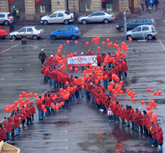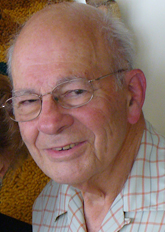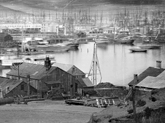Foreword by Kevin Starr
It is dangerous to generalize. It can be argued, however, that ever since the St. Charles brought the first Jewish immigrants to New Amsterdam in 1654,the predominant experience of Jews in North America has been urban. To say this is not to devalue all those Jews—including the Socialist chicken farmers of Petaluma—who lived their lives in rural or small-town circumstances. But it is to stress something obvious: the proclivity that Jewish immigrants to North America had for city life, even if their origins in the old country had been non-urban. In this regard, few cities in the United States have represented this trend more dramatically than San Francisco, the fourth largest Jewish urban community in the United States by 1860.
GermanJewish Emigres Come to San Francisco Following Political Turmoil Back Home
Following the political turmoil of 1848, a large number of German Jews immigrated to the United States. Many of these German-speaking emigres were of the educated middle class. Reform Jews in their religious practice, profoundly urban in their values and lifestyles, they did not restrict themselves to the Atlantic seaboard, but moved steadily across the continent and in the process built strong Jewish communities in such then-frontier cities as Cleveland, Cincinnati, Chicago, Louisville, St. Louis, and San Francisco.
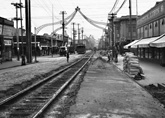
Early 1900s Fillmore Street
(Photo courtesy of Judah L. Magnes Museum)
In these cities, German Jewish emigres established businesses, raised large families, built synagogues, fostered a public school system, and assumed leadership positions in public and private life. Remembering the European cities of their earlier years, they helped their newly emergent communities grow into maturity. Adolph Sutro, for example, remembering the Aachen (Aix-la-Chapelle) of his younger years, and having made his fortune in Nevada silver, devoted his later years to the development of San Francisco as a center of commerce and culture reflective of the Aachen / Aix la Chapelle that he knew.
The problem with all of this success—in San Francisco especially—is that it can mask the full nature of the Jewish experience in 19th century America. Everyone seems so self-possessed and successful.This is not the case with later waves of Jewish emigres from Eastern Europe. Here were exploited, frequently brutalized Jews fleeing oppression, in contrast to the middle-class German Jewish emigres of the mid-19th century who voluntarily chose to come to the United States in search of better opportunities. By and large, they found these opportunities, as the history of San Francisco reveals, in terms of both the pioneering generation of the 1850s and the generations to follow. Building upon the business success of the first generation, they emerged into philanthropy and cultural leadership across the next three generations, and continue to do so to this day.
The record of this success, however, should not be allowed to obscure the full complexity of the Jewish experience, even in San Francisco. Like everyone else in the Gold Rush, the first frontier, and the provincial years that followed, Jews experienced the hardships of the long voyage or the transcontinental trek to the Pacific Coast, the danger and disease of the mines, serious illness, and, sometimes, the breakups of families, early deaths, and the orphaning or half-orphaning of children. They experienced nervous breakdowns born of disappointed hopes, unemployment in the depression of the 1870s, and other assaults on spiritual, psychological, and bodily wellbeing.
An English Jewish emigre from South Africa by the name of Joshua Norton—having experienced a nervous breakdown in the aftermath of a failed effort to corner the rice market —redesigned himself as Norton I, Emperor of the United States and Protector of Mexico, and lived at public expense. But for most other Jewish San Franciscans experiencing difficulties, this was not an option. Which was why such a representative figure as August Helbing, a 26-year-old dry-goods merchant, gathered 11 other San Francisco businessmen on 2 October 1850 to discuss forming the Eureka Benevolent Association, officially incorporated on 29 March 1851 “to afford aid and relief to indigent, sick, and infirm Jews; to bury the poor dead; and in general to relieve and aid their coreligionists who might be in poverty and distress.” A Bavarian by birth, Helbing had grown up in Munich in prosperous circumstances, was liberally educated, and as his business success in New Orleans and in San Francisco following his immigration to the United States in 1848 indicated, he knew cities, knew how they worked, knew as well how they could mask suffering in an otherwise prosperous Jewish community.
Establishment of Pacific Hebrew Orphan Asylum and Home Society
A few years later, in 1858, the Eureka Benevolent Association—having already assisted the poor, buried the dead, given shelter to the homeless, helped the unemployed find work—found itself with a baby boy on its hands after a Jewish widower from Marysville, taking his baby son to San Francisco for better care, was killed when the boiler on his steamboat on the Sacramento River exploded, leaving his son an orphan: a baby Moses found in the bulrushes of the Sacramento River not by Pharaoh’s daughter but by the entire Jewish community as represented by the Eureka Benevolent Association. To care for this child, the association established a Widows and Orphans Fund, and this in turn, in 1871, encouraged B’nai B’rith and Temple Emanu-El to form the Pacific Hebrew Orphan Asylum and Home Society and thereby create an organization that would care for innumerable children and adolescents to this very day.
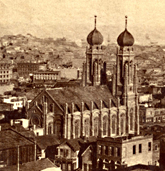
The first Temple Emanu-El, built in the late 1800s
(Photo courtesy of Judah L. Magnes Museum)
In a rambling Victorian on Divisadero or the cottages of Homewood Terrace in the sylvan southern portion of the city, or in smaller home-based communities throughout the Bay Area, this special philanthropy, brought into being to care for one solitary infant, over the decades has sheltered countless children. Later, through supervised foster care, adoption, counseling, and psychiatric services on an outpatient basis—or in other instances, by making available places for troubled young people just to hang out and, at their own pace, talk over their problems with receptive counselors—this mission of care for children and adolescents was continued at the highest possible professional level.
Tzedakah and Tikkun Olam
Two powerful concepts in the Jewish tradition—tzedakah, the Hebrew word for justice, and tikkun olam, Hebrew for “to repair the world”—animate and structure the narrative unfolding in this history. From the beginning—meaning, in San Francisco terms, from the 1850s—numerous social, cultural, and philanthropic organizations were developed by the Jewish community. Like the brooks and streams of the Sierra Nevada, these organizations in time coalesced into larger rivers, and in time these rivers merged. From the beginning, in the Jewish community of San Francisco—however remote it might have initially seemed, so far ahead of the advancing frontier, not linked to the East Coast by railroad until late 1869—global events and developing approaches to community care played equal roles alongside tzedakah and tikkun olam, justice and correction, as embedded in Jewish tradition. Global as well as local events challenged the Bay Area Jewish community from the Gold Rush onwards and shaped the various organizations and programs that in 1977 coalesced into the Jewish Family and Children’s Services of San Francisco, the Peninsula, Marin and Sonoma Counties, serving the epicenter of the fourth largest metropolitan region in the United States: an epicenter as well of American Jewish civilization, hence a community—in its people, its social and cultural life, its commerce and philanthropy—of relevance to Jews across the planet as it pursued the enduring, always developing dynamics of Jewish tradition and identity.
The Gold Rush, first frontier, and provincial Jewish society of the mid-19th century, animated by an era of commercial expansion, yielded to the unemployment of the 1870s, when so many Jewish men came west to improve their circumstances and required help. A generation of middle-class emigrants from German-speaking Europe gave way to the arrival at the end of the century of Yiddish-speaking and Polish-speaking immigrants fleeing to the New World, in many cases for their very lives. A regional capital, San Francisco, cherished home of so many Jewish Americans, was in mid-April 1906 shaken by earthquake and gutted by fire. Along with their fellow citizens, Jewish San Franciscans of every class and social condition—the working people South of Market, the more affluent and the wealthy aligned along the Van Ness corridor—watched in horror as their homes were dynamited by the Army or consumed by fire, then fled to tent or cabin life in a refugee camp in Golden Gate Park or other parks and squares in the city. This same community played a major role in rebuilding the city, further developing the Western Addition and the Fillmore corridor as a flourishing center of Jewish life.
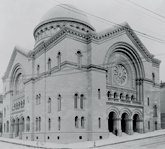
Temple Sherith Israel still stands in its 1800s location in San Francisco
(Photo courtesy of Judah L. Magnes Museum)
Later Waves of Immigration
Then came the Russo-Japanese War, the First World War, and the Russian Revolution, precipitating a small but steady influx of displaced Jewish refugees arriving in San Francisco via Harbin, China, only to have their settlement further challenged by a Great Depression that created a whole new host of social problems and challenges, requiring new organizations and strategies. In 1939, the Eureka Benevolent Society changed its name to the Jewish Family Service Agency, signifying an expansion of its activities.
Even as this depression continued through the 1930s, yet another wave of Jewish emigres, the majority of them from the German-speaking lands that first peopled Jewish San Francisco, began to arrive, many of them penniless, dispirited, speaking in anguished tones of a monstrous evil on the rise in Europe. And then, during and just after the world war in which so many Jewish San Franciscans served, there arrived survivors—tattooed numbers on their forearms—of something unspeakable whose name was Shoah or Holocaust. As a matter of scale and intensity, the atrocities of the Holocaust seemed beyond belief to sheltered Americans, were it not for the horrors being depicted, if only selectively, in the newsreels and magazines of the period. So too, 30 to 40 years following the war, Jews would be arriving from the Soviet Union, an entirely new generation of emigres, many of them highly qualified in the professions, all of them requiring assistance as they moved through the complex process of adjusting from one culture to another.
As if all this were not enough, one might say, echoing the language of Passover, American society itself was at the same time experiencing an acceleration of challenges to the mental and physical well-being of its young people, Jews included, in almost direct proportion to their percentage of the population. And so the Jewish Family Service Agency (with whom Homewood Terrace would merge in 1977), starting with its response to the youthquake centered on the Haight Ashbury, embarked upon a new round of health care and counseling services and expanded its outreach as well to a parental generation entering what could frequently seem to be an epidemic of dysfunctionalism.
Care for the Elderly
The elderly, meanwhile, a concern of the community since the 19th century, were increasing exponentially as health care improved and were living longer for the same reason. How were the elderly to live life in these newly acquired years in the best manner possible, Jewish Family and Children’s Services challenged itself? The answers were multiple, ranging from home care to assisted living singly or in groups, to recreational and educational programs, to counseling and, for those physically able, to volunteerism on behalf of the community. And how were the elderly to pass on from this life? So too did Jewish Family and Children’s Services address this delicate issue, aligning itself, among other alternatives, to a homebased hospice program.
And thus, in its concern for final things, history was repeating itself, a circle was being circled; for among August Helbing’s earliest concerns in the 1850s was the dignified death and burial of an elderly Jewish resident, somehow finding himself at the end of his life in this brawling city on the empty edge of the North American continent.
The following narrative is primarily a history of an organization. Through well-selected photographs and quotations, however, it offers as well the images and voices of the San Francisco and Bay Area Jewish past, which in turn allows that past to reappear in its own image and to speak for itself in its own voice. We see the headlong, overnight frontier city, nonexistent
as an American place until 1847, by 1870 the tenth largest city in the United States and a city of considerable importance to its American Jewish community, where the hybrid architecture of Temple Emanu-El in the downtown blended Gothic Revival with the Byzantine and the Levant, thus evoking the complex cultural heritage of the German Reform, now translated to these far Pacific shores.
A pair of original Levis suggest the commercial fortunes being assembled. The printed brochure “Constitution and By-Laws of the Eureka Benevolent Society” underscores the development of social philanthropy. One can appreciate the manly presence of August Helbing, hands nonchalantly tucked into his pockets, his top hat tilted at a rakish angle, his side whiskers bespeaking a gentleman with proper self-regard, his muscular frame suggesting the young firebrand who on the voyage out to San Francisco from New Orleans threatened a gunfight with another man trying to take over his cabin, then generously surrendered it to a cabin-less Jewish couple and their child and spent the voyage sleeping on the deck in the cold and wet open air. We see seven Kosher butchers, aligned behind the counter of the Shenson Brothers Kosher Sausage Company at 1149 McAllister Street in the heart of the rapidly developing post-earthquake Jewish community of the Western Addition. The baseball team and the band from the orphanage show off their natty new uniforms. Other young men are instructed in woodworking at the same institution. Boys and girls do their homework in the library. During the First World War, uniformed youngsters proudly display the American flag.
Helping All Those in Need
And the voices, not heard fully yet there, some evoked in quotations, others not even present on the printed page, but heard nevertheless in imagination: voices from the past, an elderly man dying far from home in a Gold Rush city, the cry of the orphaned infant pulled from a burning wreck on the Sacramento River. It is a lusty cry, as the cry of Moses must have been to have been heard by Pharaoh’s daughter: crying, this little Moses, this orphaned infant, on behalf of his own isolation, his lost mother and father, and thereby anticipating the sense of isolation that so many Jewish youngsters, equally deprived of one or another or both parents, would also experience in the decades to come, only to have this pain, this isolation, alleviated by the very same Jewish community to which these children would forever belong as a matter of birthright.
Tzedakah and tikkun olam. Serve justice, ensure fairness, repair a torn world. And do this out of Jewish particularism, which is to say, out of Jewish care for its own community, as well as out of the universal implications and legacies of the Jewish experience. Take care of one Hebrew orphan, and 120-plus years later, the successor organization is caring for the orphans of Southeast Asia arriving in the United States from their devastated homelands. Take care of the widow, the orphan, the unemployed, the confused, the physically disabled, the elderly, and in so doing serve the Jewish community but also set an example for—and in so many instances, cooperate with—Americans of other religious traditions in a combined effort to struggle for justice and to assuage the pain of a broken world.
—San Francisco, October 2010
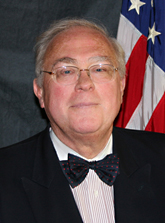
Kevin Starr is a fourth-generation San Franciscan whose ancestors arrived in 1852. He is the author of eight books about “Americans and the California Dream” and a Professor of History at the University of Southern California.
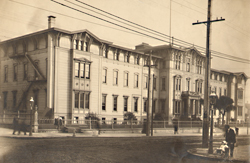 “As the oldest charitable organization west of the Mississippi, the dynamic story of JFCS mirrors the history of California,” acknowledges United States Senator Dianne Feinstein (D-California) on the book jacket. “Innovation and a generous spirit combine to make the San Francisco Bay Area a wonderful—and unique—region. This book engages us in exploring how it came to be so, through the eyes of those who helped create it.”
“As the oldest charitable organization west of the Mississippi, the dynamic story of JFCS mirrors the history of California,” acknowledges United States Senator Dianne Feinstein (D-California) on the book jacket. “Innovation and a generous spirit combine to make the San Francisco Bay Area a wonderful—and unique—region. This book engages us in exploring how it came to be so, through the eyes of those who helped create it.”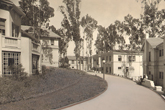

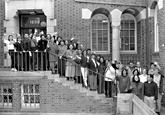
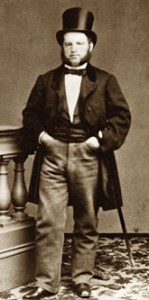
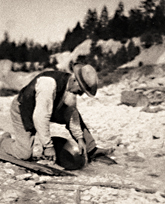




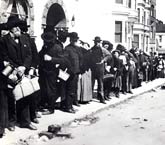
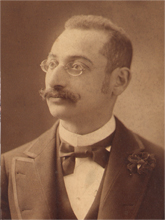 The 190 children of the Pacific Hebrew Orphan Asylum were sleeping peacefully in the early morning hours of April 18, 1906 when the earthquake struck. Superintendent Henry Mauser rushed them all outside and then, two days later, into the gymnasium. Many members of the community pitched in, providing food and other necessities for the next month.
The 190 children of the Pacific Hebrew Orphan Asylum were sleeping peacefully in the early morning hours of April 18, 1906 when the earthquake struck. Superintendent Henry Mauser rushed them all outside and then, two days later, into the gymnasium. Many members of the community pitched in, providing food and other necessities for the next month.